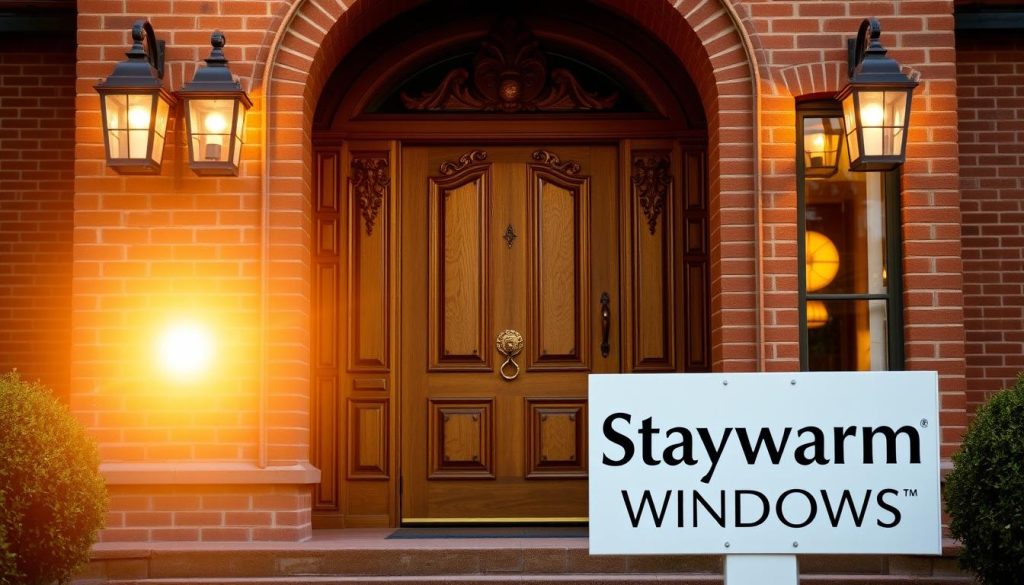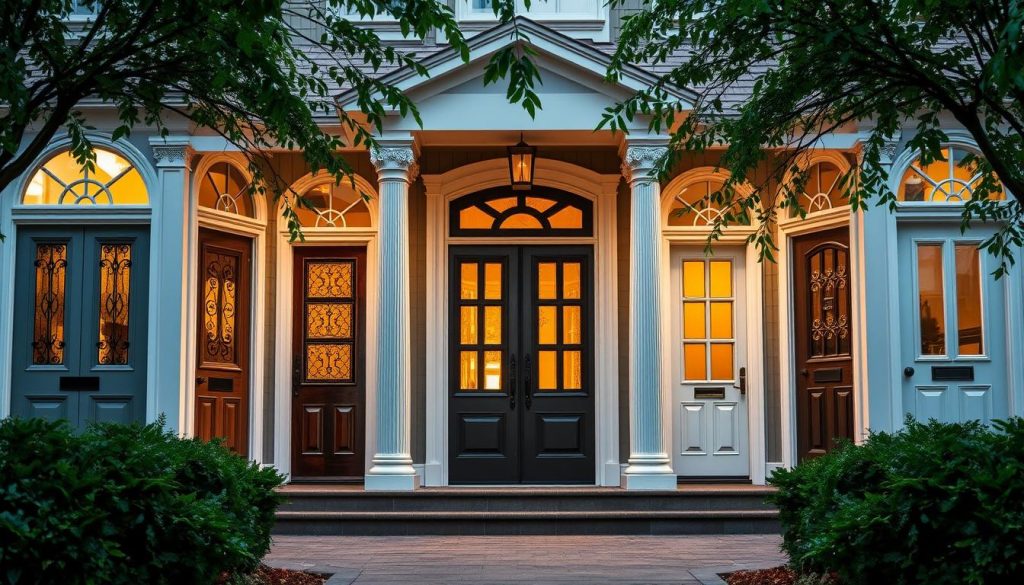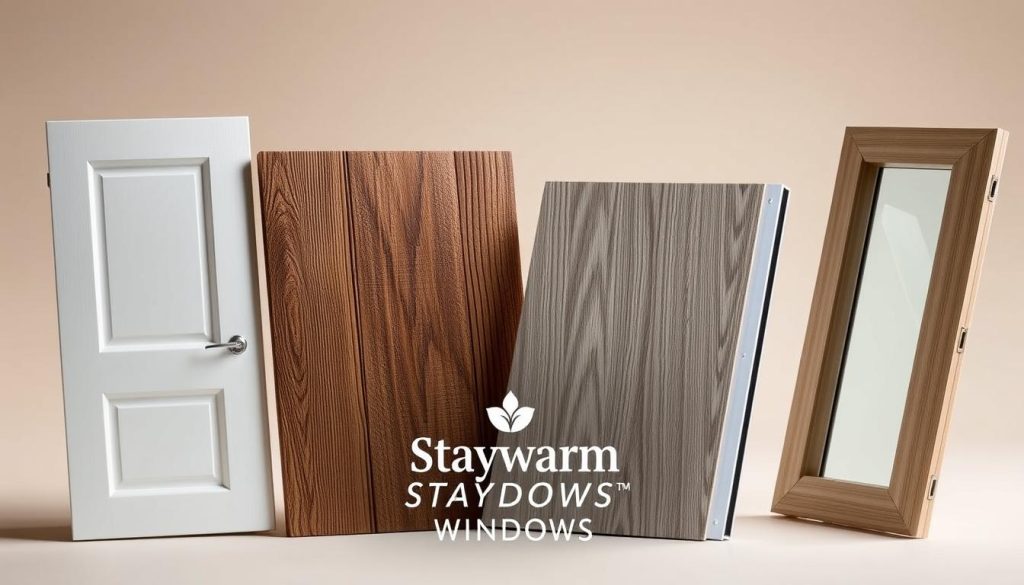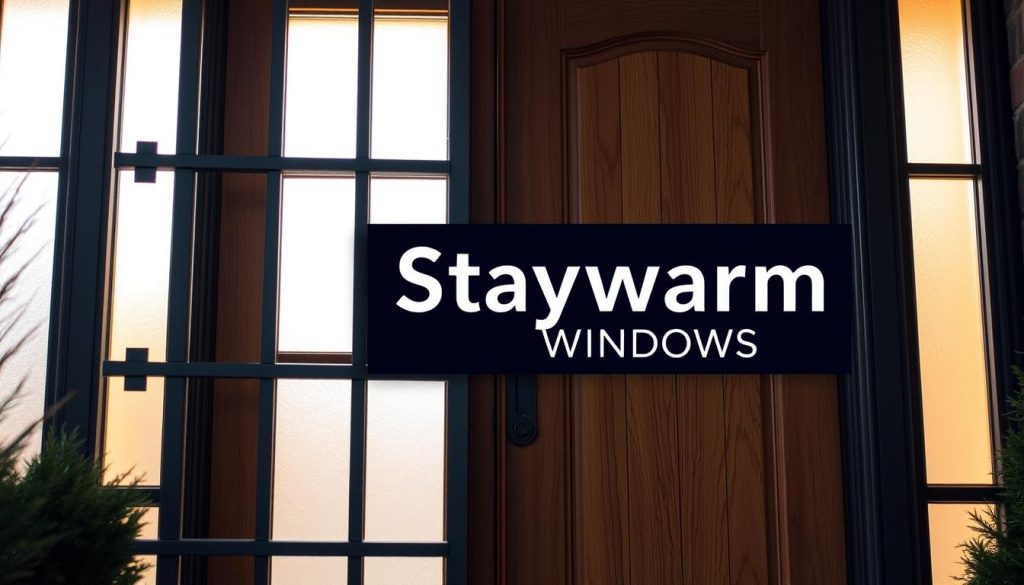Can one simple change really lift kerb appeal, save energy and make your home feel safer?
Your front door is the first impression for visitors and it shapes how your home looks and feels. It also affects warmth, security and day‑to‑day comfort.
Modern choices include uPVC, timber, composite and aluminium. Composite doors blend glass‑reinforced skins, insulated cores and sturdy frames. They often outperform alternatives for strength, thermal efficiency and security.
This buyer’s guide will help you weigh style, performance and cost so you can pick options that last. Expect clear advice on measuring, budgeting and spotting key features such as insulated cores, quality seals and advanced locks.
We’ll cover how colour, glazing and hardware lift design while keeping privacy and safety in mind. By the end, you’ll be ready to shortlist suppliers and brief installers with confidence.
Key Takeaways
- First impressions matter: the entrance sets your home’s tone.
- Materials like composite often balance security and thermal gains.
- Look for insulated cores, robust frames and quality locks.
- Design choices—colour, glazing and hardware—affect both style and privacy.
- Measure carefully and check standards before you order or fit.
Why your front door matters today: kerb appeal, security and efficiency
A strong entrance can transform kerb appeal while quietly improving warmth and security.
First impressions count. The right front door makes your home feel cared for and in keeping with its style. It also affects daily comfort and resale appeal.
Beyond looks, security matters. Good locks, solid frames and quality fitting raise resistance to forced entry. Composite options often score highly for strength and protected cores.
Thermal performance affects bills in the UK climate. Better insulation and tight seals cut heat loss and draughts, improving overall efficiency and comfort.
Upgrades reduce noise and lift hallway light and operation. Small gains — smoother handles, neat glazing and firm thresholds — shape how visitors experience your entrance.

- Kerb appeal: modernises a façade and complements internal décor.
- Security: robust build plus correct fitting deters intruders.
- Energy and efficiency: insulated cores and seals limit heat loss.
| Aspect | Composite | uPVC | Timber |
|---|---|---|---|
| Security | High — layered skins and strong cores | Moderate — depends on frame and locks | Good — can be very strong if well made |
| Energy performance | Excellent — insulated cores reduce heat loss | Good — performance varies by profile | Variable — can need more maintenance to stay efficient |
| Kerb appeal | Wide range of styles and colours | Functional, low maintenance | Classic look, high aesthetic value |
Choosing a New Front Door: a step-by-step decision framework
Start by matching your entrance to the era and scale of your property.
Match the door to your home’s architecture
Assess the house first. A cottage suits a planked, rustic look while Victorian terraces work well with paneled profiles and period glazing.
Contemporary homes favour cleaner lines, minimal glazing and modern fittings. These choices keep the entrance in harmony with the rest of the build.

Prioritise what matters most
Decide your main factors: security, energy, budget or low maintenance. Priorities narrow down suitable types quickly.
For higher insulation and strength, consider composite. For low upkeep, uPVC can work; for classic looks, timber remains popular.
Decide on size and configuration
Pick single leaf for most homes. Double leaves, side lights or transoms add presence and daylight.
- Think about daily use — hallway space, push/pull swing and wider access for mobility.
- Balance glazing for light with privacy; frosted or decorative panels are smart compromises.
- Shortlist finishes and hardware to suit exterior colours and your interior visible from the hall.
Front door materials and types: comparing uPVC, timber, composite and aluminium
Material choice determines long‑term durability, upkeep and thermal performance.
Different materials bring clear trade‑offs. Consider maintenance, cost and how each material performs in British weather. Below is a concise comparison of the main options available so you can match form and function to your home.

uPVC: low maintenance value
uPVC offers straightforward value. It is low maintenance, affordable and secure at sensible price points.
Styling flexibility and lifespan are more limited than other materials, so check profiles and hardware before you buy.
Timber: classic aesthetics and upkeep
Timber gives rich character and repairability when well made. High‑quality timber can last many years.
Plan for periodic painting or staining to preserve looks and performance; that affects lifetime cost.
Composite: strength, security and thermal efficiency
Composite doors combine glass‑reinforced skins with an insulated core for excellent thermal efficiency and strong security.
They usually demand minimal upkeep but cost more up front. Rockdoor’s 360° aluminium‑reinforced inner frame, dense PU foam and optional steel mesh show how engineering adds real value.
Aluminium: sleek lines and durability
Aluminium doors suit modern façades with slim sightlines and robust longevity. They often cost more initially but perform very well when specified with thermal breaks.
- Thermal performance: composite typically leads; uPVC and quality timber sit mid‑range; aluminium depends on thermal specification.
- Security features: multi‑point hook locks (25mm throw) and S Glaze increase long‑term resistance and appearance.
- Value over time: weigh initial outlay against maintenance cycles, repainting and energy savings to judge true cost.
| Material | Strength | Maintenance | Thermal efficiency |
|---|---|---|---|
| uPVC | Moderate | Low | Good |
| Timber | Good | Regular | Variable |
| Composite | High | Low | Excellent |
| Aluminium | High | Low–Moderate | Strong (with thermal break) |
Security essentials for UK homes: locks, frames and glazing that protect
Good protection combines proven locks, tough glazing and sturdy frames.
Security must be system-led. The lock, the glass and the frame should work together to resist forced entry.

Multi-point locks, anti-snap cylinders and robust frames
Prioritise multi-point locking that engages at several places along the leaf. Hook bolts and sintered steel hooks with a 25mm throw give real resistance and sealing.
Use anti-snap cylinders rated TS007 3-star or SS 312 Sold Secure Diamond to stop cylinder attacks.
A quality door frame and correct fixings are vital. Poor anchoring undermines any lock, so insist on reinforced or timber frames that are bedded into strong masonry.
Laminated or toughened glazing and secured-in glass
Choose laminated or toughened glass to delay impact and entry. Systems that lock the glazing into the leaf, such as S Glaze, remove weak external cassettes.
- Look for PAS 24 or Secured by Design accreditation for proven performance.
- Secure hinges with hinge bolts to prevent lifting from the hinge side.
- If you pick composite or aluminium doors, confirm reinforcement and cylinder specs in writing.
Energy efficiency and weather performance: choosing doors that keep heat in
A well-specified entrance keeps heat inside and cold out, saving bills and improving comfort.
Insulated cores, weather seals and U-values explained
Insulated cores are central to energy performance. Dense foam layers limit conductive heat loss through the door leaf and lift thermal efficiency.
Quality weather seals stop draughts and rain. Check compression, alignment and continuous sealing around the perimeter for long‑term protection.
U‑values show how well a product resists heat transfer—the lower the figure, the better. Compare like‑for‑like specs and include glazed areas when you judge performance.
Fitting and frames: why installation quality affects thermal performance
Proper fitting is non‑negotiable. Poor installation can leave gaps that undo manufacturer ratings.
Frames must match the slab’s performance and be fitted square and plumb. Use expanding foams and perimeter sealants to reduce air leakage.
“Good specification and careful fitting improve comfort, reduce energy costs and help your home feel consistently warm.”
| Feature | What to check | Benefit |
|---|---|---|
| Insulated core | Dense PU or foam core | Lower conductive heat loss |
| Weather seals | Continuous compression around leaf | Fewer draughts, less rain ingress |
| Glazing | Low‑E, warm edges, double/triple panes | Improved overall U‑value |
| Installation | Square frame, correct fixings, foams | Manufacturer performance achieved in the home |
Style and design choices: colours, hardware and glazing to suit your home
Colour, glazing and hardware decide whether an entrance feels bold, subtle or timeless.
Start with colour as your anchor. Timeless blacks, soft whites and heritage greens suit period properties, while anthracite grey gives a sleek, modern edge. Confirm real finishes with samples because gloss, satin or woodgrain textures change how colour reads in daylight.
Glass choices for light and privacy
Glass can brighten a dark hallway or protect privacy. Clear panes maximise light; frosted glass and patterned panels keep sightlines private. Decorative inserts add period charm without losing security.
Hardware that works hard
Hardware defines the final look. Brass, stainless steel and chrome each set a different tone. Pick handles, knockers, letterboxes and numbers that match your chosen style and finish.
- Palette tip: mid-tone colours hide marks better than very light or very dark shades.
- Practicality: include draught brushes on letterplates and robust weather bars for durability.
- Coordination: use aluminium accents for contemporary properties and traditional trims for period homes.
- Finish details: check symmetry and sightlines—aligned glazing, panels and hardware make the entrance feel resolved.
Buying and budgeting: measurements, warranties and installation
Good planning keeps surprises down—measure carefully and factor in installation needs.
How to measure an existing frame accurately
Measure width and height in three places (top, middle, bottom and left, centre, right). Note the smallest figures so the slab fits the frame without sticking.
Record the depth of the reveal to specify the correct threshold and sill. If you are unsure, book a professional survey — this avoids costly reorders and delays.
Setting a realistic budget: price, fitting and extras
Build a budget that covers the new door, glazing upgrades, hardware, trims, removal of the old unit and installation. Clarify lead times and schedule; most straightforward swaps can be completed within one day when the opening is sound.
Ask for evidence of PAS 24 testing and clear manufacturer guarantees: structural cover, paint/finish warranties and sealed unit assurances.
Check aftercare guidance for cleaning and maintenance intervals, and confirm who to contact if adjustments are needed.
- Compare like-for-like quotes — identical glass specs, hardware and security cylinders.
- Plan access on installation day, protect floors and allow parking to keep work on time and tidy.
“Accurate measures, realistic budgets and verified warranties keep projects on track and protect your investment.”
Living with your new door: maintenance, longevity and value
Regular care keeps your entrance working smoothly and looking cared for for years.
Simple routines make maintenance straightforward. Clean surfaces with warm soapy water and a soft cloth. Avoid abrasive cleaners or harsh chemicals that damage finishes and glazing.
Lubricate hinges and locks periodically. Check weather seals for compression and wear. These small checks keep closing pressure consistent and cut draughts.
Upkeep by material
- Composite front and composite front doors: generally low maintenance. Wipe down and check seals yearly.
- uPVC: use gentle cleaners; specialist uPVC products can remove stubborn marks if needed.
- Timber: needs scheduled re-finishing to protect against moisture and UV over the years.
- Aluminium: low maintenance — regular wipe downs and occasional hinge lubrication are normally enough.
Spot signs early and call a pro
Watch for stiff locks, sagging hinges, condensation between panes or flaking paint. Address small faults quickly to protect warranties and avoid larger repairs.
If you see failed sealed units, warped frames or major surface damage, contact a professional. Prompt expert help prevents escalation and keeps your home secure.
| Issue | What to check | Action |
|---|---|---|
| Stiff lock | Lubricate cylinder and check alignment | Try lubricant; call locksmith if persistent |
| Condensation in glazing | Sealed unit failure | Replace sealed unit professionally |
| Sagging | Hinges and frame fixings | Adjust hinges or seek installer help |
Conclusion
An entrance should balance look, performance and long‑term value for your home.
Composite doors often deliver that mix: strong cores, low maintenance and good thermal performance. Look for PAS 24 certification, robust warranties and clear details on steel reinforcement and the door frame.
Aluminium suits modern styles, timber offers classic appeal and uPVC remains a sensible value choice. Prioritise real security features, insulated cores and sealed glazing to protect comfort and energy bills.
Shortlist reputable suppliers, check colour samples (anthracite grey is popular) and confirm installation and aftercare. With clear specs and proper fitting, your front door will add kerb appeal, strength and long‑term benefit to your home.



